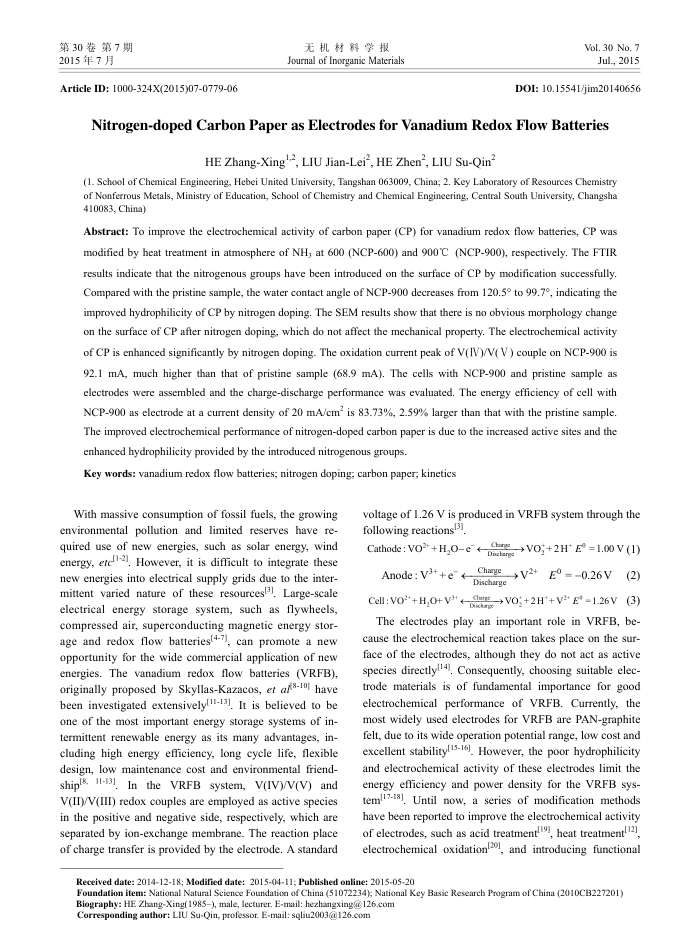您当前的位置:首页>论文资料>全钒液流电池用碳纸电极掺氮改性的研究
内容简介
 第30卷第7期 2015年7月
第30卷第7期 2015年7月Article ID: 1000-324X(2015)07-0779-06
无机材料学报 Journal of Inorganic Materials
Vol. 30 No. 7 Jul.,2015
DOI:10.15541/jim20140656
Nitrogen-doped Carbon Paper as Electrodes for Vanadium Redox Flow Batteries
HE Zhang-Xing'-2, LIU Jian-Lei2, HE Zhen", LIU Su-Qin?
(1. School of Chemical Engineering, Hebei United University, Tangshan 063009, China; 2. Key Laboratory of Resources Chemistry of Nonferrous Metals, Ministry of Education, School of Chemistry and Chemical Engineering, Central South University, Changsha 410083, China)
Abstract: To improve the electrochemical activity of carbon paper (CP) for vanadium redox flow batteries, CP was sa06006e00eoee results indicate that the nitrogenous groups have been introduced on the surface of CP by modification successfully. Compared with the pristine sample, the water contact angle of NCP-900 decreases from 120.5° to 99.7°, indicating the improved hydrophilicity of CP by nitrogen doping. The SEM results show that there is no obvious morphology change on the surface of CP after nitrogen doping, which do not affect the mechanical property. The electrochemical activity of CP is enhanced significantly by nitrogen doping. The oxidation current peak of V(IV)/V( V) couple on NCP-900 is 92.1 mA, much higher than that of pristine sample (68.9 mA). The cells with NCP-900 and pristine sample as electrodes were assembled and the charge-discharge performance was evaluated. The energy efficiency of cell with NCP-900 as electrode at a current density of 20 mA/em is 83.73%, 2.59% larger than that with the pristine sample. The improved electrochemical performance of nitrogen-doped carbon paper is due to the increased active sites and the enhanced hydrophilicity provided by the introduced nitrogenous groups.
Key words: vanadium redox flow batteries; nitrogen doping; carbon paper, kinetics
With massive consumption of fossil fuels, the growing environmental pollution and limited reserves have re-quired use of new energies, such as solar energy, wind energy, etcli-2]. However, it is difficult to integrate these new energies into electrical supply grids due to the inter-mittent varied nature of these resources[3].
Large-scale
y storage system, such as flywheels,
electrical energy
compressed air, superconducting magnetic energy stor-
age and redox flow batteries
canpromoteanew
opportunity for the wide commercial application of new
energies
he
batteries (VRFB)
redoxflow
ranadium
y Skyllas-Kazacos
originallyproposedb
been investigated extensivelyt
one of the mos termitten
ortantener
a/(8-10) have
It is believed to be
ystor
stems of in-
n
cluding high energy efficiency, long
cycle life, flexible
design, low maintenance
shiplk
costand
VRFB
the
system
nental friend-V(IV/V(V)
and
V(II)/V(IlI) redox couples are employed as active species in the positive and negative side, respectively, which are separated by ion-exchange membrane. The reaction place of charge transfer is provided by the electrode. A standard
voltage of 1.26 V is produced in VRFB system through the following reactions(3].
Cathode : Vo2*+ H,O e* + Anode : V3++ e" +
Discharye
→VO; +2H* E° =1.00 V (1)
→ V2+
Eo = 0.26 V
(2)
()A9"=+A+,H+A+A+0"H++;OA: The electrodes play an important role in VRFB, be-cause the electrochemical reaction takes place on the sur-face of the electrodes, although they do not act as active species directlyl14). Consequently, choosing suitable elec-trode materials is of fundamental importance for good electrochemical performance of VRFB. Currently, the most widely used electrodes for VRFB are PAN-graphite felt, due to its wide operation potential range, low cost and excellent stabilityl1s-16], However, the poor hydrophilicity and electrochemical activity of these electrodes limit the energy efficiency and power density for the VRFB sys-
tem/17-18]
Until now, a series of modification methods
have been reported to improve the electrochemical activity of electrodes, such as acid treatmentl19), heat treatment[12] electrochemical oxidation[20), and introducing functional
Received date: 2014-12-18; Modified date: 2015-04-11; Published online: 2015-05-20
Foundation item: National Natural Science Foundation of China (51072234); National Key Basic Research Program of China (2010CB227201)
Biography: HE Zhang-Xing(1985), male, lecturer. E-mail: hezhangxing@126.com Corresponding author: LIU Su-Qin, professor. E-mail: sqliu2003@126.com